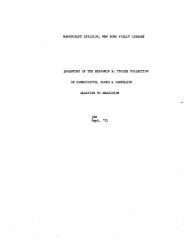pdf available - Multiple Choices
pdf available - Multiple Choices
pdf available - Multiple Choices
You also want an ePaper? Increase the reach of your titles
YUMPU automatically turns print PDFs into web optimized ePapers that Google loves.
One of the most important institutions was<br />
the Jewish gemine, or kehila (organized Jewish<br />
community). The kehila, in conjunction with the<br />
municipality, had a tremendous influence on the<br />
Jewish community in Libivne. It is therefore no<br />
wonder that Jewish interest in the functioning of<br />
the kehila was always great and that there were<br />
always controversies over its decisions among the<br />
various sectors of the Libivne Jews.<br />
The fights in and about the kehila were not<br />
always about economic interests. Its concerns<br />
also encompassed local Jewish and general Jewish<br />
problems. It was for this reason that the<br />
various political parties strove so hard to have an<br />
ever stronger position in it.<br />
Whenever the elections to the kehila were<br />
approaching, the atmosphere in town became<br />
cheerfulgatherings in the synagogues and in<br />
the shtibls; street meetings; talks and fights in<br />
private homes. The assemblies were heated affairs.<br />
Quite often they had to be interrupted; at<br />
times they grew into general free-for-alls. There<br />
were vital interests for which people fought. We<br />
must not forget that the kehila had the power to tax<br />
the Jews in order to carry out some of the purposes<br />
permitted it by the government.<br />
The Libivne kehila was established around<br />
1923-24. Elections were held every four years,<br />
and the following officers were elected for the<br />
1926-30 term: chairmanMoyshe Reyzman; secretaryShimon<br />
Shor, the former official government-appointed<br />
rabbi for the town; and his alternateMoyshe<br />
Greenberg; Hershl Lifshitz, Yitshak<br />
Shloyme Sirtchuk, Moyshe Sfard, Meyer<br />
Landgeyer, and Shepsl Rabinovich.<br />
In 1935, the chairman was Meyer Yitshak<br />
Veytsfrucht, who was also head of Libivne<br />
Mizrachi (Orthodox Zionist Party); the secretary<br />
was Moyshe Lifshitz. The executive board consisted<br />
of Yisroel Mekler, Hersh' Lifshitz, Yehoshua<br />
Grimatlicht, Moyshe Kaufman, Aron Rusman,<br />
Yitshak Dubetsky, and Yankl Peretszon, and they<br />
served until 1939.<br />
New elections to the kehila took place in<br />
1939, the year of the outbreak of the war. The new<br />
council members were: chairmanAsher<br />
Tenenboym; membersAvrom Grimatlicht,<br />
Yankl Peretszon, Avrom Lichtmacher, Motl<br />
FROM DAILY LIFE 141<br />
Krayzer, Velvl Sheynvald, Nachum Shtern, and<br />
Yosl Berger.<br />
Town Hall was the shtetl's economic nervecenter.<br />
In the first elections of the early 1920s all<br />
12 elected members of the town council were<br />
Jewish. The position of mayor was, naturally, to be<br />
Jewish too. The Poles, however, did not like the<br />
whole business and looked for all kinds of excuses<br />
to invalidate the elections. And because they<br />
had a strong "pull," they naturally achieved<br />
their purpose.<br />
According to a new plan, the shtetl was<br />
subdivided into regions, and neighboring villages<br />
were attached to each region. This ruse<br />
created a situation where the Jews, instead of<br />
being a majority, became a minority because of<br />
the newly added non-Jewish population of the<br />
villages. And the result was that the number of<br />
Jewish representatives in the kehila was reduced<br />
at first to eight and later to four. The<br />
municipal officers were: the mayora Pole;<br />
the vice-mayora Ukrainian; secretarya Jew,<br />
Yankl Shtern.<br />
During the last days before the war, Yankl<br />
Shtern served as a deputy to the city's mayor. I<br />
remember some of the names of people on the city<br />
council (at various times): Moyshe Klerer (Revisionist<br />
party), Motl Privner (Poale Tsion), Yitshak<br />
Handlsman (Artisan), Shaye Sheyntop (Bund),<br />
Shimon Shor, Moyshe Esterzon, Asher Rusman,<br />
Zhenye Afeldman.<br />
Just as in the other Polish towns, the Poles of<br />
Libivne also appointed a committee to beautify<br />
the appearance of the shtetl. The committee had<br />
a "beautiful" name, but its hidden purpose was<br />
to weaken the economic base of the Jews.<br />
Under the guise of beautifying the shtetl, and<br />
in the name of better sanitary conditions, the Poles<br />
introduced a motion in the city council to transfer<br />
the marketplace to an area outside the town. As in<br />
other towns, the marketplace was actually the<br />
main source of livelihood for most of the Jewish<br />
population.<br />
Moving the marketplace would have been an<br />
economic death-knell for the Libivner Jews. The<br />
Jews therefore strongly opposed the proposed plan,<br />
and with much effort succeeded in seeing to it that<br />
the marketplace would remain where it was. The







